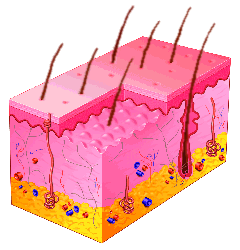The Skin is the largest organ of the body, and it’s also the only one permanently on show. It serves a number of different functions: it is protective (it covers all the other organs), it's involved in communication through touch (which tells us when we’re in danger) and colour (who hasn't gone bright red with embarrassment?), in heat and fluid regulation, and sexual attraction (which is the basis of the make-up industry). It is continually being touched or caressed or stroked or scratched or poked or prodded and must have the capacity to regenerate in order to replace itself, because even in the absence of injury skin cells are continuously being shed in their thousands each day.


 - Tell me more about the skin.
- Tell me more about the skin.